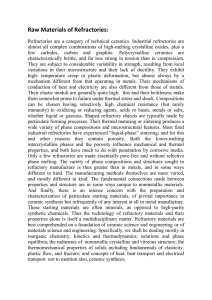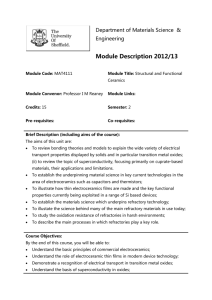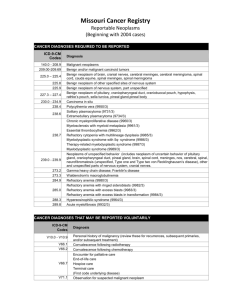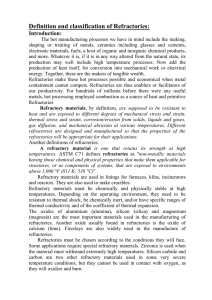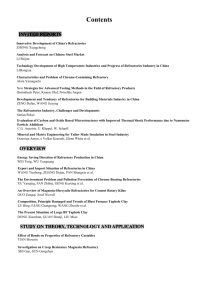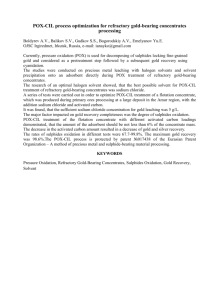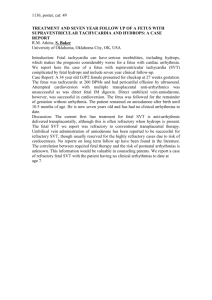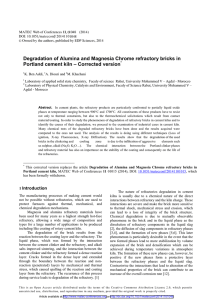Raw Material challenges in refractory application
advertisement
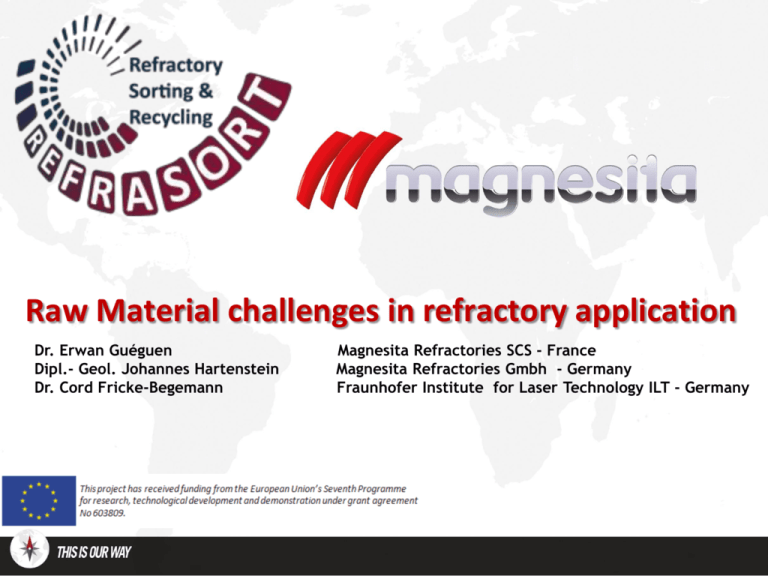
Raw Material challenges in refractory application Dr. Erwan Guéguen Dipl.- Geol. Johannes Hartenstein Dr. Cord Fricke-Begemann Magnesita Refractories SCS - France Magnesita Refractories Gmbh - Germany Fraunhofer Institute for Laser Technology ILT - Germany Refractory Industry Overview 2 Refractory Classification By Application: Unshaped Products also called Monolithics versus Shaped Products (namely bricks). By Type of bonding for Shaped products: Ceramic bonded bricks (carbon free) = Fired bricks Carbon bonded bricks = Tempered bricks By Chemical behaviour which depends upon the main raw material: There are acid, neutral and basic Products. Basis for this is the reaction with Water: Example Oxide + Water = Acid Silica Oxide + Water = no Reaction Alumina Oxide + Water = Basic Magnesia 3 Refractory Raw Material The most important Raw Materials for Refractories are: 4 Refractory Raw Material Pure Materials have a defined Melting Point. The Melting Point of a Mixture is always below the Melting Point of the Pure Components. Eutectic point. Fireclay Brick (45% Al2O3) Lowering of Melting Point ≈ 1200°C !! Reaction Slag Dolomite Brick (58% CaO) 5 Refractory properties versus Raw Material Thermal Properties like • Thermal Expansion, • Heat Capacity, • Thermal Conductivity, • Refractoriness (Refractoriness under Load – Creep in Compression), Are determined by the Refractory Raw Material Physical Properties like • Raw Density – Porosity – Permeability, • Crushing Strength – Modulus of Rupture, • Elasticity, • Thermal Shock Resistance, Are mainly determined by the Raw Material and Production Process. Wear Resistance or Corrosion Resistance do not depend on the Raw Materials only or the Production Process. They are influenced significantly by the Conditions in Use. (Steel Grades – Slag Type - Temperatures, Kiln Type Local Atmosphere,...) 6 Refractory Product conception Oxides C containing bricks Resin, Pitch, Oil,... Fired Bricks Temporary Binder, Phosphate, Clay,... Antioxydant for instance Al/ Si/ Al-Mg/ B4C CaB6 Binders Refractory Additives 7 MgO, Doloma, Alumina,...or combination Carbon Sources Micropowders, ..... Graphite Carbon Black Refarctory microstructure Typical microstructure of Mag-C bricks Binder Magnesia Binder 8 Graphite Magnesia Important Refractory Raw Materials Source: PRE 9 Raw Material price trends (2007-2013) Significant price increase for: - Bauxite - Graphite - Sintered Magnesia - Fused Magnesia Source: PRE 10 Critical Raw Materials for EU List of Critical Raw Materials edited by EU in 2014 : 54 Materials reviewed from which 20 are considered as being critical EU commission Statement: « It’s worth recalling that all Raw Materials, even when not critical, are important for the European Economy, and therefore not being critical doesn’t imply that a given Raw Material and its availability to the European economy should be neglected » 11 Raw Material Challenge for Refractory Refractory suppliers are under significant pressure with respect to... … how to still improve in the customers the value in use of products The industry is highly exposed to international competition Invest and increase the use of own raw materials and strictly control of the costs Raw materials represents 40-50% of the cost of refractories Develop use of externally sourced recycled refractory materials Raw materials play a fundamental role on product quality China is currently the main supplier of high volume of important Refractory grade raw materials Development of supply chain for obtaining used refractory materials that can be successfully processed and used for refractory brick production Besides Raw material cost, energy cost and environmental regulation 12 REFRASORT Project European Commision 7th Framework Programme for Research, Technological development and Demonstration Funding of new Research projects for shaping a more ressource efficient economy in Europe REFRASORT Project « Innovative Technologies for High Grade Recycling Refractory waste using non destructive technology » Objective = To develop an automated sorting and separation technology for used Refractory material without comminution which provides pure high quality secondary raw materials adapted to the needs of Refractory production 13 LIBS technology Key technology to enable automated separation = identification of individual pieces of Refractories Direct Laser analysis promises to fulfil the sensor requirements for industrial operation in a separation plant Sensor-based Sorting System using Laser Direct Analysis for Material Identification Laser-induced Plasma on a Piece of used Refractory 14 LIBS technology Ability of LIBS to distinguish main types of Refractories MgO Doloma 15 Al-Si THANK YOU FOR YOUR ATTENTION 16



